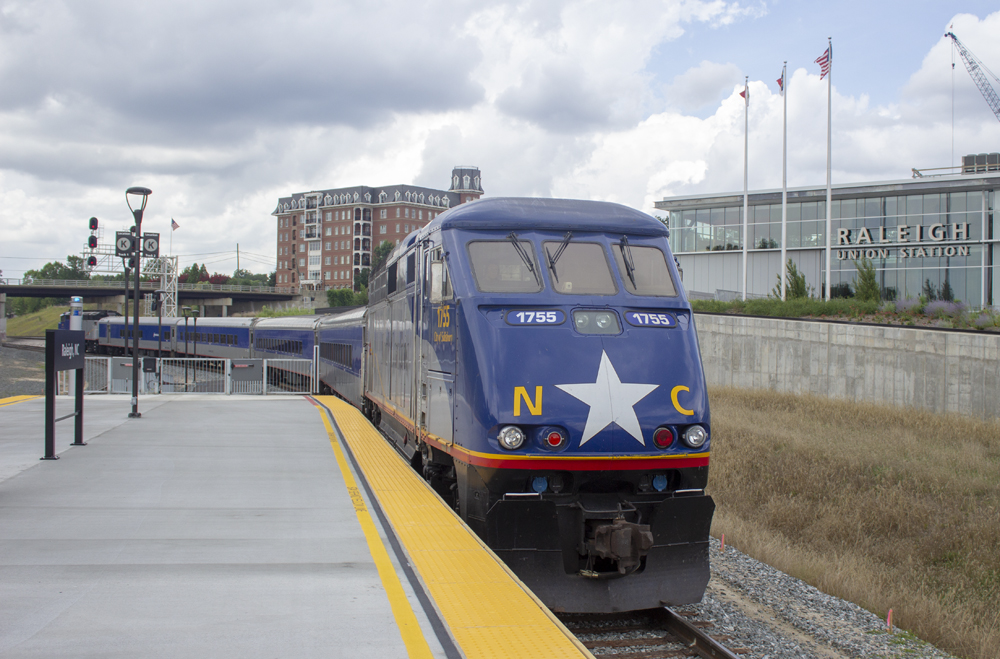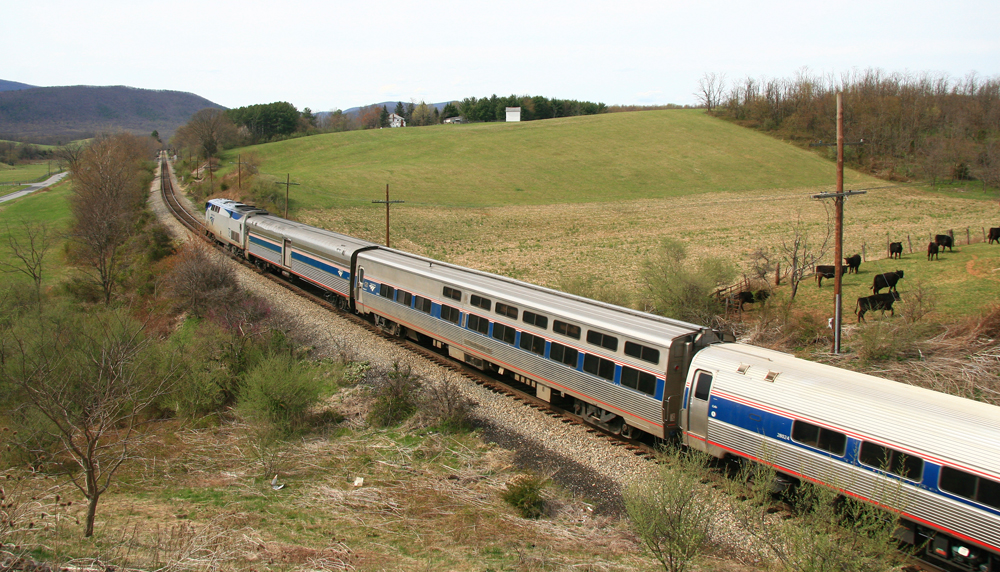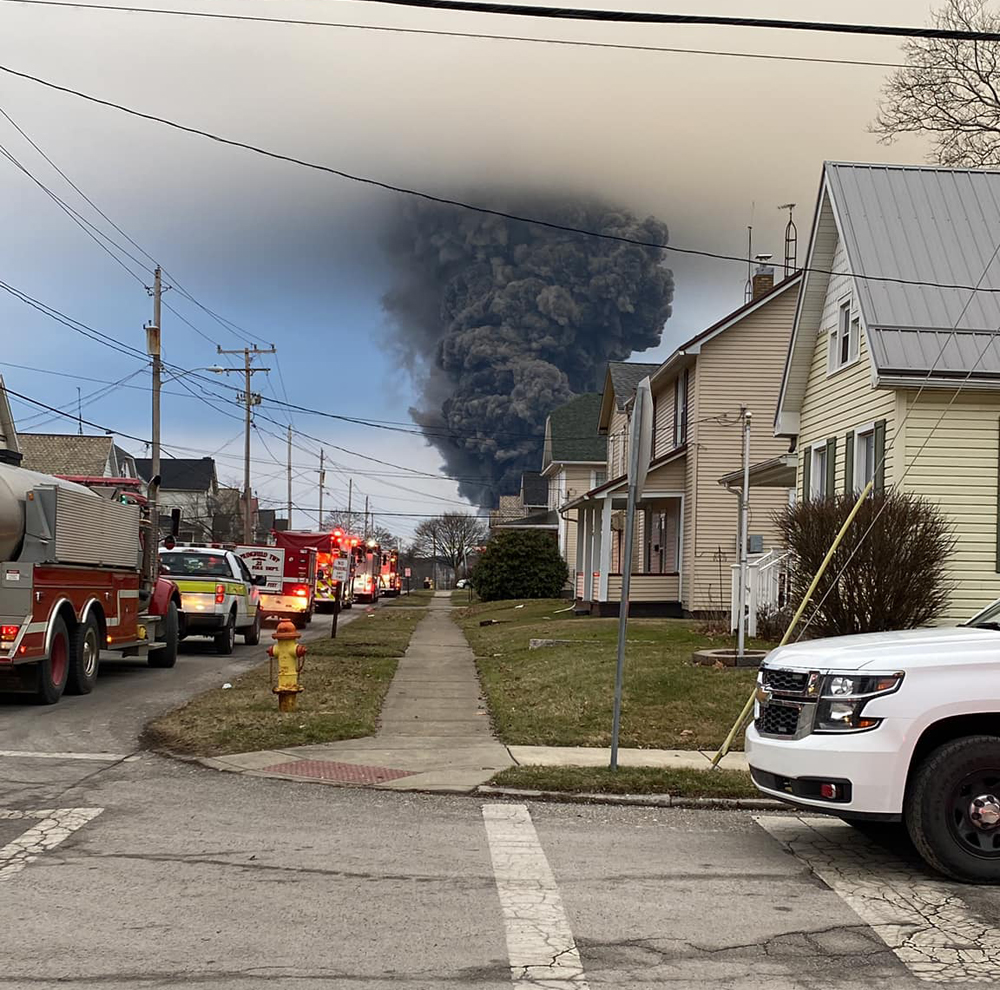
WASHINGTON — Seven routes in North Carolina and four serving Ohio are among those to receive funding to study possible future Amtrak service under the Federal Railroad Administration’s Corridor Identification and Development Program, according to announcements today (Tuesday, Dec. 5) by members of Congress, as well as one mayor.
At least 14 corridors have been selected by the FRA. While the agency will at some point release a full list of corridors selected, elected officials usually have the first opportunity to announce such awards to their constituents, and not all such announcements may have been made yet. As such, the list below may be incomplete.
The program, created under the Infrastructure Investment and Jobs Act, is to facilitate development of intercity passenger rail routes [see “FRA unveils Corridor ID and Development program …,” Trains News Wire, May 17, 2022]. Each corridor selected receives $500,000 for a study to determine the engineering, cost and other requirements needed to establish service; more on the program and its requirements is available here.
Corridors selected for funding, as announced today, include:
— Asheville, N.C., to Salisbury, N.C.
— Charlotte, N.C., to Washington, D.C.
— Charlotte to Atlanta
— Charlotte to Kings Mountain, N.C.
— Fayetteville, N.C., to Raleigh, N.C.
— Raleigh to Wilmington, N.C.
— Raleigh to Winston-Salem, N.C.
— Cleveland-Columbus-Dayton-Cincinnati
— Cleveland-Toledo-Detroit
— Chicago-Fort Wayne, Ind.-Columbus, Ohio-Pittsburgh
— Chicago-Indianapolis-Cincinnati-Washington-New York (Daily Cardinal service)
— Nashville, Tenn.-Chattanooga-Atlanta
— Scranton, Pa., to New York
— Reading, Pa., to Philadelphia
Sen. Thom Tillis (R-N.C.) announced the funding for the corridors in his state, and in a statement quoted by WCCB-TV, said, “This $3.5 million in grant funding to identify and develop potential rail lines across North Carolina could be transformational in how North Carolinians travel.” The Charlotte-Atlanta corridor is an intended high speed line; the other corridors increase frequencies on existing routes, or are lines connecting to and complementing the state’s existing Piedmont and Carolinian services.

U.S. Sen. Sherrod Brown (D-Ohio) announced the selection of the four routes serving Ohio — including the effort to increase frequency for the Cardinal. He said that, in addition to providing the initial $500,000 in funding, inclusion in the Corridor ID program gives the routes priority in future funding competitions. The Ohio Rail Development Commission sponsored the Cleveland-Columbus-Cincinnati and Cleveland-Detroit routes, while the Mid-Ohio Regional Planning Commission helped sponsor the Chicago-Pittsburgh route and Amtrak sponsored the daily Cardinal application.
“Today’s announcement is a great first step toward expanding Amtrak in Ohio,” Brown said in a press release. “Good Amtrak service shouldn’t be a privilege only for people on the coasts. These new routes would expand opportunity, help grow businesses and create jobs, and connect communities in Ohio and across the Midwest.”
The City of Chattanooga had applied for the grant for the Nashville-Chattanooga-Atlanta route, and Chattanooga Mayor Tim Kelly said in a press release that the grant “shows the broad support for and momentum behind our vision of reconnecting us to other major Southern cities by bringing passenger rail back to Chattanooga. There aren’t many places in America whose history is as closely tied to rail travel as Chattanooga’s and today’s announcement is a promising sign that the railroad will continue to be an important part of our future.”
The Scranton-New York service seeks to restore the Lackawanna Cutoff, last used for passenger service in 1970, and projects three daily round trips, with nine stations and travel times of 2 hours, 50 minutes [see “Study says Scranton-New York passenger service could carry more than 470,000 …,” News Wire, March 23, 2023]. NJ Transit is already working to restore a portion of the route to Andover, N.J., projected to enter service in 2026.
“This is a significant milestone and represents years of dedicated efforts to restore passenger rail service, which will contribute to our region’s economic growth and vitality,” U.S. Rep. Matt Cartwright, who announced funding for the Scranton-New York route along with Sen. Bob Casey, said in a press release. “This proposed rail line will create jobs, improve quality of life, and offer convenient travel options for commuters, college students and tourists, alike. It will also connect those of us living in Northeast Pennsylvania to a wider selection of health care services, sporting events, cultural activities and vacation spots.”
At 64 miles, the Reading-Philadelphia route might be the shortest in the Corridor ID program. A press release from Rep. Madeleine Dean (D-Pa.) says the service would offer four to eight round trips per day, with intermediate stops in Pottstown, Phoenixville, and Norristown, Pa., and extend to New York City. The Schuylkill River Passenger Rail Authority is the grant recipient.
“We are thrilled to hear that the Schuylkill River Passenger Rail project was selected into the Federal Rail Administration’s Corridor ID Program,” said Jim Gerland, CEO of the Greater Reading Chamber Alliance. “Reestablishing passenger rail access from Reading to Philadelphia and beyond is a once in a generational economic development opportunity for this region.”














St. Louis, whose station was once the busiest in the nation, isn’t on any lists I’ve seen for new or restored service. What a shame.
In Ohio a daily Cardinal is a good start. What happened to the proposal for additional Cleveland to New York service via Buffalo and Pittsburgh.
Mr. Shoemaker – Columbia make sense until you realize that South Carolina did not submit a single project to the Corridor ID list. No application – no trains or studies.
Scranton-NY is a no-brainer. The PA Counties bought the RR from Scranton to the NJ border years ago for the purpose of restoring passenger service. NJT owns the RR to Hoboken and if you want to go to Penn Station NY, Amtrak has a connection at “SWIFT.” (Tailor made, eh?)
They don’t have to beg a Class 1 for trackage rights.
Charles, that’s BS & you know it the Hwy Trust Fund has been broke since 2008 they’ve been siphoning money from the Treasury since then to fund hwy projects. The bulk of the Infrastructure Bill is going to hwys because drivers didn’t want to pay more gas tax for their joyriding. The Federal gas tax has not been raised since Bill Clinton was President!
Curious why the daily Cardinal moves ahead, and the Daily Sunset application didn’t?
It seems passenger rail projects need to justify their need & potential to receive their funding unlike highway projects that are built whether they benefit many or just a few.
That’s because until recently highway projects were apid out of user fees.
Beyond time for this great news for Scranton, Penna.!!!
I have felt for some time that these studies are a complete and total waste of taxpayer dollars. The most accurate “study” that could be done would be to simply “find” some equipment and begin running the service on a trial basis for six months or a year to see how much of a public response there would be.
If there were to be a significant public response, then funds could be applied later for track and station improvements. I have this suspicion that that is what a private company would to. Just start running the train, doggone it, and promote it like hell.
If there is a big public response, fine. If not, then maybe it wasn’t such a good idea after all. Unfortunately, that just doesn’t seem to be the way things work nowadays. At one time, that is the way things were done but no more. It’s a darn shame, really.
Charlotte to Kings Mountain??? Charlotte to Columbia would be a better choice.
Charlotte to Kings Mtn is the shortest “corridor” at 32 miles along the NS main to ATL, parallel to a very congested I-85 during rush hour. The Crescent stops in Gastonia NC along this route in the middle of the night in both directions. NCDOT could probably extend the Piedmont service trains the extra 32 miles to Kings Mtn. A new station is needed at Kings Mtn and probably a larger station with parking in Gastonia. Since the NS main also cuts across the northern edge of the CLT airport NCDOT might as well add a stop there too.